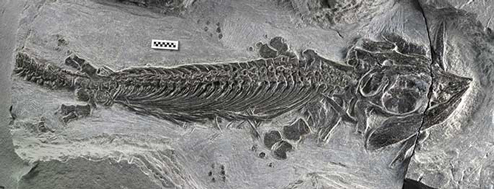Short Snouted Basal Ichthyosauriform from the Lower Triassic of China
It had long been predicted, but until now one of the enduring mysteries of the marine reptiles had remained unsolved. One of the most successful clades of marine vertebrates ever to have existed were the ichthyosaurs , reptiles that form the Order Ichthyosauria (fish lizards), also known as the Ichthyopterygia (fish flippers). These animals thrived in the seas and oceans for much of the Mesozoic but unlike other types of back-boned animals that had adapted to a life in water, no fossils of transitional forms showing a link with terrestrial ancestors had been found.
Ichthyosaur Origins
However, this week a team of researchers led by scientists from the University of California have published a paper detailing the discovery of an amphibious ichthyosaur, an animal that, although adapted to a life in the sea was still capable of clambering about on land. This specimen is believed to represent a transitional form, between the Ichthyosauria and their terrestrial ancestors.
Writing in the science Journal “Nature”, the researchers document a nearly complete specimen (just the end of the tail is missing), of a forty-centimetre-long, amphibious reptile that is probably part of a group of animals that were the ancestors of the nektonic ichthyosaurs, widely regarded by many palaeontologists as the most well-adapted to a marine existence of all the reptiles.
The Fossil Specimen that Indicates a Transitional Form
Picture credit: University of California – Davis/Professor Motani
Commenting on the research, lead author Professor Ryosuke Motani (University of California, Department of Earth and Planetary Sciences) stated:
“But now we have this fossil showing transition. There’s nothing that prevents it from coming onto land.”
From Anhui Province
Professor Motani and his colleagues uncovered the fossil specimen in eastern China (Anhui Province) from Lower Triassic strata believed to date from around 248 million years ago (Olenikian faunal stage). Unlike the long-snouted fully marine ichthyosaurs this animal, which has been named Cartorhynchus lenticarpus, had a short snout, its bones were also heavier, traits associated with fully terrestrial ancestors.
Cartorhynchus lenticarpus
Unlike later ichthyosaurs, the flippers were large in proportion to the body size and the wrists flexible. These features helped this creature crawl around on land, in a similar way to extant seals. C. lenticarpus means “truncated snout with flexible wrists”, an apt name for this little reptile that spent part of its life on land. During the early part of the Triassic, eastern China was covered by a shallow tropical sea, there were numerous small islands, the whole area resembled the Caribbean today. The isolated islands with their limited resources probably acted as a spur for vertebrate evolution. There was plenty of food in the sea but it was a question of being able to reach it, this probably led to the evolution of reptiles that were more at home in water than their ancient ancestors.
The researchers also had to consider the implications of the Permian mass extinction event on the evolutionary pressures that these animals were under. Just four million years earlier, planet Earth had undergone the most devastating extinction event known in the history of our planet. More than 95% of all life on Earth died out.
A spokesperson from Everything Dinosaur explained:
“Extinction events mean the inevitable demise of many genera and families. However, for those organisms able to survive, such events open up a whole range of new opportunities and often there is a “burst” of evolution as animals and plants adapt to take advantage of vacated niches and new resources.”
Scientific Collaboration
Collaborating with the University of California were scientists from the Chinese Academy of Sciences, Peking University, Anhui Geological Museum, the University of Milan, and the Field Museum (Chicago). As a basal Ichthyosauriform has been discovered in China, and the most primitive true ichthyosaurs are also known from Triassic rocks from this region, then it is likely that the Ichthyosauria evolved in this part of the world. This clade then radiated out and occupied a number of ecological niches including apex predatory positions before dying out in the Late Cretaceous.
Later ichthyosaurs were agile, swimmers, although the end of the tail is missing, scientists speculate that Cartorhynchus lenticarpus was probably a relatively poor swimmer. It probably hunted soft bodied animals and arthropods in coastal waters.
For replicas and figures of ichthyosaurs and other marine reptiles: CollectA Age of Dinosaurs Popular Figures.







Leave A Comment